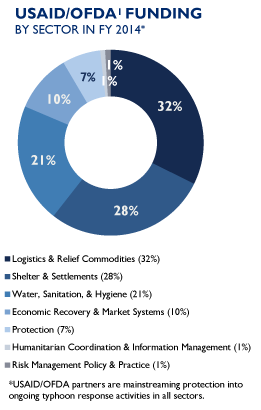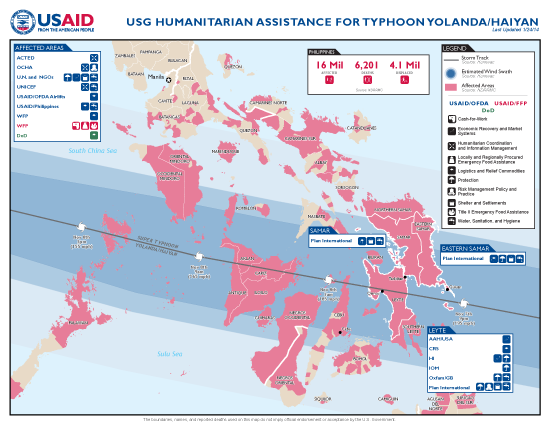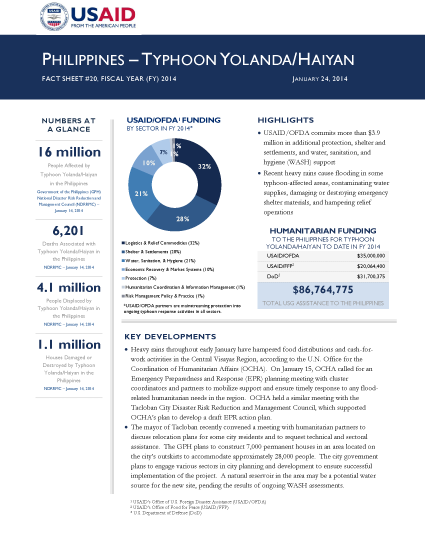- What We Do
- Agriculture and Food Security
- Democracy, Human Rights and Governance
- Economic Growth and Trade
- Education
- Ending Extreme Poverty
- Environment and Global Climate Change
- Gender Equality and Women's Empowerment
- Global Health
- Water and Sanitation
- Working in Crises and Conflict
- Disaster Assistance
- Political Transition Initiatives
- Conflict Mitigation and Prevention
- Countering Violent Extremism
- Disaster Risk Reduction
- Peacebuilding and Reconciliation
- Providing Safe & Secure Environments for Development
- Recovering From Crisis
- Resilience
- Tech Challenge for Atrocity Prevention
- World Humanitarian Day
- U.S. Global Development Lab
January 24, 2014
Numbers At A Glance
16 million
6,201
4.1 million
1.1 million
Humanitarian Funding:
To The Philippines For Typhoon Haiyan/Yolanda To Date In FY2014:

| USAID/OFDA | $35,000,000 |
| USAID/FFP | $20,064,400 |
| DoD | $31,700,375 |
| TOTAL | $86,764,775 |
Typhoon Haiyan / Yolanda Fact Sheet #20 - 01/24/14 ![]() (pdf - 225k)
(pdf - 225k)
Highlights
USAID/OFDA commits more than $3.9 million in additional protection, shelter and settlements, and water, sanitation, and hygiene (WASH) support.
Recent heavy rains cause flooding in some typhoon-affected areas, contaminating water supplies, damaging or destroying emergency shelter materials, and hampering relief operations
Key Developments
Heavy rains throughout early January have hampered food distributions and cash-for-work activities in the Central Visayas Region, according to the U.N. Office for the Coordination of Humanitarian Affairs (OCHA). On January 15, OCHA called for an Emergency Preparedness and Response (EPR) planning meeting with cluster coordinators and partners to mobilize support and ensure timely response to any flood-related humanitarian needs in the region. OCHA held a similar meeting with the Tacloban City Disaster Risk Reduction and Management Council, which supported OCHA’s plan to develop a draft EPR action plan.
The mayor of Tacloban recently convened a meeting with humanitarian partners to discuss relocation plans for some city residents and to request technical and sectoral assistance. The GPH plans to construct 7,000 permanent houses in an area located on the city’s outskirts to accommodate approximately 28,000 people. The city government plans to engage various sectors in city planning and development to ensure successful implementation of the project. A natural reservoir in the area may be a potential water source for the new site, pending the results of ongoing WASH assessments..
HEALTH AND NUTRITION
Between December 15 and January 11, health partners reported 15 suspected cases of measles in Tacloban. The U.N. Children’s Fund (UNICEF) and the U.N. World Health Organization (WHO) are coordinating measles vaccination campaigns, as well as disease confirmation and surveillance activities in Tacloban and surrounding typhoon-affected communities. UNICEF and WHO are also coordinating with the GPH Department of Health (DoH), which conducts routine measles vaccinations for children countrywide, including in typhoon-affected areas.
As of January 14, five of eight hospitals in Tacloban were fully functioning, according to the U.N. In addition, WHO reports that 40 foreign medical teams remain in typhoon-affected areas to provide health care to affected populations.
Since December 2013, health organizations have conducted 48 reproductive health missions in Capiz, Eastern Samar, Iloilo, and Leyte provinces, benefiting more than 7,500 women through pre- and post-natal checkups, family planning counseling, health information sessions, and hygiene kit distribution, according to OCHA.
As of January 20, humanitarian organizations had screened more than 84,000 children under five years of age for malnutrition, with 2,510 children identified as suffering from acute malnutrition, including 319 cases of severe acute malnutrition and 2,182 cases of moderate acute malnutrition.
In December, blanket supplemental feeding programs reached approximately 95,500 children between six months and five years of age, according to the U.N. World Food Program (WFP) and the Nutrition Cluster—the coordinating body for humanitarian nutrition activities, comprising U.N. agencies, non-governmental organizations (NGOs), and other stakeholders. WFP is targeting nearly 139,000 children through various interventions during the month of January. In addition, humanitarian partners have reached approximately 9,700 pregnant and lactating women with infant and young child feeding services at 37 baby-friendly spaces.
AGRICULTURE AND FOOD SECURITY
OCHA reports that emergency food assistance will continue until the beginning of the next rice production season, which starts in May. Nearly 5.6 million people require food assistance and support to prevent food insecurity and restore agriculture and fishing livelihoods.
The U.N. Food and Agriculture Organization (FAO) has distributed rice seed to approximately 39,600 farmers, representing 90 percent of the targeted population of 44,000 beneficiaries. FAO estimates that the rice seed will yield sufficient quantities of rice during the March/April production season to feed approximately 800,000 people for one year.
In an effort to align with the U.N.’s Strategic Response Plan (SRP), the Food Security and Agriculture Cluster (FSAC) plans to shift from the emergency assistance phase—which included food and seed distributions and cash activities—to the recovery phase—which will include sustainable and targeted agriculture and fishery activities.
FSAC partners will continue working with the GPH Department of Agriculture and GPH Bureau of Fisheries and Aquatic Resources to ensure proper planning for all agriculture and fishery recovery activities. The cluster is also in the process of developing and planning assessments to monitor FSAC activities over the coming months.
Since the beginning of the emergency operation, WFP has reached more than 2.7 million beneficiaries through general food distributions, approximately 104,000 people through nutrition interventions, and more than 283,000 beneficiaries through cash transfers. As of January 16, WFP had dispatched a total of 21,835 metric tons (MT) of food, including 21,457 MT of rice, 43 MT of specialized nutrition products, and 335 MT of high-energy biscuits (HEBs). USAID/FFP has provided $20 million in food assistance since WFP's emergency operation in the Philippines began in November, making USAID/FFP the largest contributor of food assistance to WFP's emergency operation to date.
As part of its $20 million contribution, USAID/FFP has provided more than 6,020 MT of U.S.-sourced rice and 55 MT of US-sourced emergency food products, including nutritional pastes and rice and wheat bars, valued at more than $8.6 million in total. In addition, USAID/FFP has contributed $11.45 million for the purchase of 2,400 MT of locally purchased rice and 40 MTs of supplemental HEBs, as well as support for cash-based programming, including cash transfers to help affected families purchase food on local markets and cash-for-work and cash-for-assets activities. Through its contributions, USAID/FFP has provided critical life-enhancing food assistance reaching more than 3 million people affected by the typhoon.
LIVELIHOODS
The U.N. reports that the typhoon affected the livelihoods and income sources of approximately 5.9 million workers. Current Livelihoods Cluster activities target 400,000 workers—or 7 percent of typhoon-affected workers. Humanitarian partners continue to develop comprehensive strategies to meet the ongoing recovery needs of fisherfolk and coconut farmers, who are still underserved by recovery efforts, according to OCHA.
Humanitarian partners continue to implement livelihoods activities, including skills training for re-employment in Cebu Province, microenterprise development for small-scale shopkeepers in northern Cebu, and livelihoods restoration programs in Leyte Province.
Humanitarian partners are preparing medium- and long-term recovery interventions and have begun supporting livelihoods through cash programs and alternative livelihoods strategies, including vegetable, swine, and poultry farming.
PROTECTION
The Gender-Based Violence (GBV) Working Group is strengthening referral systems for reported cases of GBV, as well as supporting child-friendly spaces throughout Eastern Samar, Leyte, and Samar provinces. In Eastern Samar, humanitarian partners have established a GBV referral mechanism through short messaging service (SMS), with reports referred to municipal and provincial social workers for response.
The Child Protection Working Group—which has established a hub in Ormoc city, Leyte Province—plans to work with other clusters on the issue of child labor, as well as develop a plan of action to support the SRP.
USAID/OFDA recently provided nearly $370,000 to Plan International to support protection activities, including strengthening local networks and educating communities on protection-related issues, in Tacloban city.
SHELTER AND SETTLEMENTS
More than 26,000 people remained in evacuation centers as of January 16, according to OCHA and the International Organization for Migration (IOM). Lack of recovery shelter and limited transitional shelter options are prolonging the stay of displaced populations in evacuation centers, OCHA reports. Humanitarian organizations are supporting the GPH Department of Social Welfare and Development (DSWD) and the GPH Department of Public Works and Highways (DPWH) to identify alternative sites for internally displace persons (IDPs) currently housed in schools; however, partners report a need for more clarity regarding no-build zones in order to continue resettlement support and activities. The GPH plans to construct a total of 1,200 bunkhouse units in Tacloban City. In an effort to meet international humanitarian standards, the GPH has agreed to allocate two bunkhouse units to each large household, decreasing the number of beneficiaries to approximately 600 families. Humanitarian partners report the need for transitional shelter programs or temporary settlement solutions over the next six months as relocation sites are planned and developed. Inter-cluster leads—including the Camp Coordination and Camp Management (CCCM), Protection, Shelter, and WASH clusters—recommend that the GPH prioritize IDPs residing at school evacuation centers, as well as people displaced from no-build zones, for resettlement in bunkhouses. Humanitarian partners plan to hold further discussions on beneficiary selection criteria with the Tacloban City Social Welfare and Development Office (CSWD) and the DSWD for the bunkhouses. CCCM Cluster partners are also in the process of identifying temporary shelter sites where families can live until proper transitional and permanent shelters are identified. DPWH reports that bunkhouse construction will finish on schedule, despite delays at some construction sites, including the installation of power and water supplies. CSWD will become responsible for site management once the bunkhouses are allocated to beneficiaries. USAID/OFDA recently provided approximately $2.3 million to Plan International to support shelter and settlements activities benefiting affected populations in Tacloban city. USAID/OFDA-supported activities include the provision of repair kits to families with damaged houses and transitional housing for families with fully damaged homes, as well as support for host communities. Plan International is incorporating disaster risk reduction elements into all USAID/OFDA-funded shelter and settlements activities.
WASH
Relief organizations are working with the DoH to conduct vector control activities in 56 priority sites around Tacloban. The CCCM Cluster reports that vector control activities are recommended before IDPs relocate to transitional bunkhouse sites.
USAID/OFDA partner Oxfam/Great Britain (Oxfam/GB) plans to establish a WASH hub in Ormoc, significantly increasing WASH coverage in western Leyte.
Recent rains in typhoon-affected areas have caused flooding at some emergency centers and re-contaminated water supplies, OCHA reports. Partners continue implementing WASH interventions to repair damaged water systems and increase access to safe drinking water. As of January 14, humanitarian partners had provided water kits to at least 151,000 typhoon-affected people and hygiene kits for nearly 189,000 affected people.
USAID/OFDA recently provided nearly $1 million to Plan International to rehabilitate household water points, re-establish connections to municipal water systems, and support other WASH-related humanitarian activities in Tacloban city.
INTERNATIONAL ASSISTANCE
The Asian Development Bank (ADB) has announced a $500 million emergency assistance loan to help the GPH meet immediate budgetary requirements for reconstruction and rehabilitation. An additional $375 million loan through DSWD will support community-based development projects in 75 municipalities in Eastern Visayas Region. ADB will also administer a $20 million grant—provided by the Japan Fund for Poverty Reduction—to develop the capacity of local authorities to manage reconstruction and long-term resilience, as well as support the delivery of social services and livelihoods restoration programs.
As of January 23, international donors had pledged approximately $633 million to address the needs of populations affected by Typhoon Yolanda/Haiyan. The total amount pledged represents more than 80 percent of the $788 million requested by the U.N.’s SRP for the Philippines.









Comment
Make a general inquiry or suggest an improvement.